Advanced Search 2.0
Since of Shopware 6.5.6.0, AdvancedSearch will only use OpenSearch.
Advanced Search is part of the Commercial extension and is available to you as an extension from the Shopware Evolve plan.
SaaS customers can already use Advanced Search without any further installation.
Advanced Search offers you simple configuration options and high performance due to the OpenSearch basis.
Requirements
Since Advanced Search is based on OpenSearch, an OpenSearch instance is a prerequisite for operation. You can learn how to integrate OpenSearch into Shopware 6 here.
Additionally, the Commercial extension must be installed & activated. More information about the Commercial extension can be found here.
Special Characters in Product Numbers
By default, Shopware allows only a predefined set of special characters to prevent issues with indexing and search. This configuration is defined in the file /src/Core/Framework/Resources/config/packages/shopware.yaml under preserved_chars:
preserved_chars: ['-', '_', '+', '.', '@']Since shops often use their own special characters, it is recommended to adjust the configuration if needed. To do so, create a file config/packages/shopware.yaml and override the preserved_chars setting to add the required characters, for example:
shopware:
search:
preserved_chars: ['-', '_', '+', '.', '@', '/']In all new Shopware projects, the installation under config/packages/ now contains only a lock.yaml file. This may also be the case if you performed an update and the .yaml files under config/packages/ were part of the default setup.
If this applies to your installation, you need to create a new shopware.yaml file and add the configuration adjustments there!
General
The settings for the Advanced Search can be found in the Admin under Settings > General > Search.
Search behaviour

Advanced Search can be configured per sales channel (1) and can be enabled/disabled via Enable Advanced Search (2).
In this section, you can also configure how the search function handles search queries consisting of multiple words and when the search function is triggered.
If you select ‘AND’ search, the search function will only display results that contain all terms, e.g. searching for ‘pink beach ball’ will only display results that contain beach and ball.
The ‘OR’ search function returns any result that matches one of the terms. For example, searching for ‘pink beach ball’ will display results that contain pink or beach ball.
The search is triggered when the minimum search term length is reached.
Searchable content
The searchable content in Shopware Search determines which product information, category information or manufacturer information is included in the search results and how strongly it influences the ranking.

In the General section (1), you can display and configure the default searchable content. If you click on the Custom Fields tab (2), you can display and configure the user-defined searchable content.
Dropdown menu (3): Here you can switch between product, category and manufacturer. Depending on the selected area, the corresponding content will be displayed.
- Reset to default (4): This button resets all default searchable content to the default values.
- Content (5): Here you can specify how a particular piece of content should be treated by the search function.
- Searchable (6): Shows you whether the corresponding content is included in the search.
- Ranking score (7): Defines how much value is attached to the content. The higher the value, the higher the ranking.
- Split search terms (8): Search terms with certain special characters such as - or / and so on are split up. For example, the product number is PT-64/515. If activated, it would search for PT, 64 and 515. If it is inactive, it will not be split up, and PT-64/515 will be searched for.
- ‘...’ menu (9): This menu allows you to reset a specific piece of content to the ranking score or edit the “Searchable”, ‘Ranking score’ and/or ‘Separate search terms’ options.
Search results
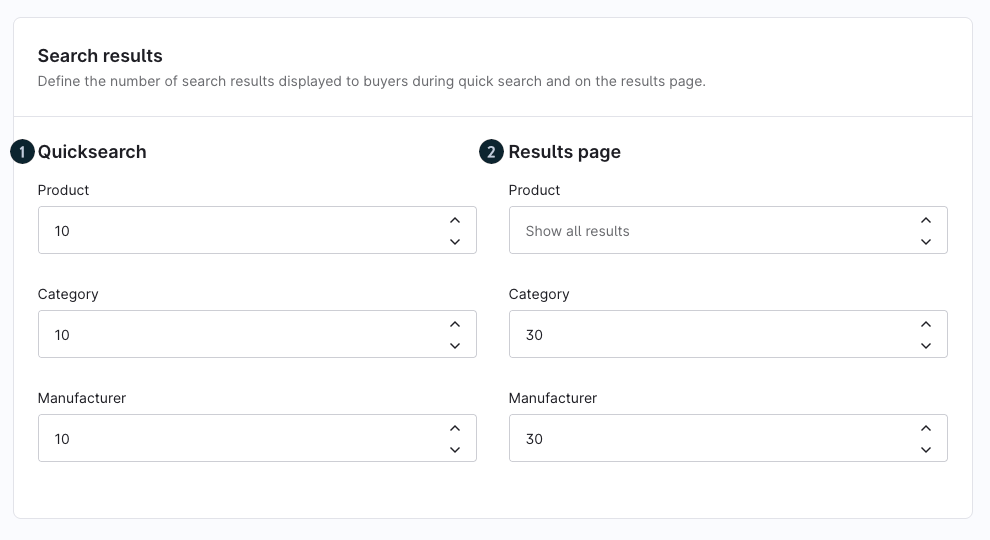
In the Search results section, you define the number of items displayed for the Quicksearch (1) and the results page (2).
Boostings
The boosting settings are available from Commercial Plugin Version 5.5.0.
In addition to prioritising individual data records to be searched, it is possible to create additional boostings.
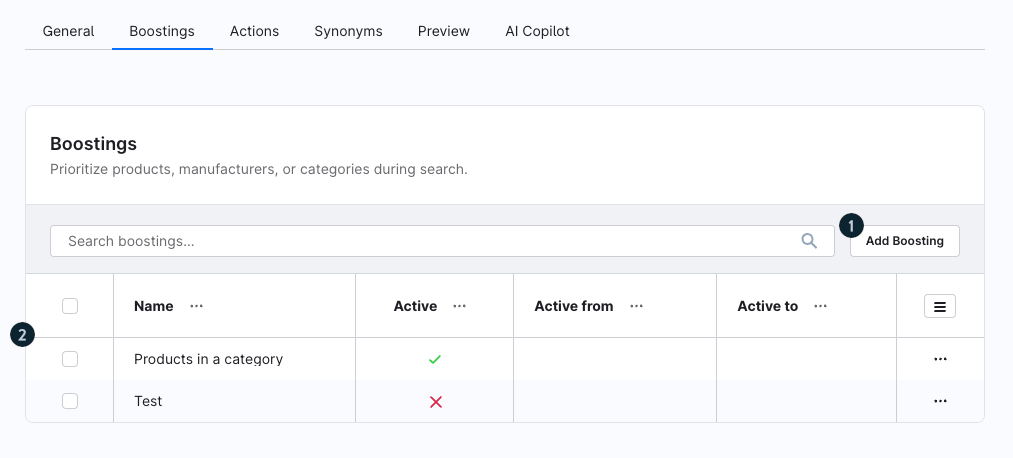
Boosting offers you targeted configuration options, such as displaying certain products higher up in the search results.
With Add Boosting (1), you open the form to create a new boosting.
The lower section (2) displays all existing boostings for the sales channel, including their active status and time period. Click on the name or the context menu ‘...’ and then on Edit to edit a specific boosting.
New boosting
When you create a new boost, some basic settings apply to all boost types. You can create boosts for products, categories, and manufacturers.
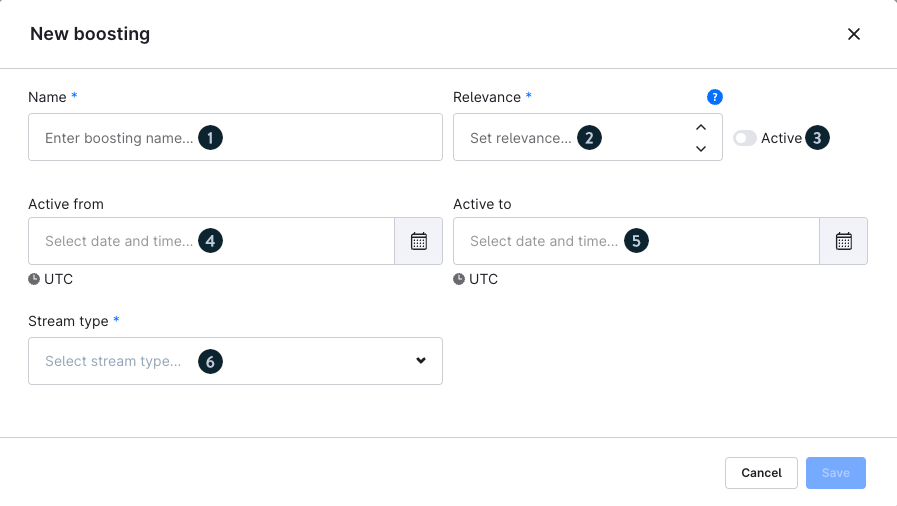
Name (1): Enter the name of the boost here.
Boost (2): In this field, enter the desired relevance of your boost.
Active (3): Use this switch to activate or deactivate your boost.
Active from (4): Optionally, it is possible to use the boosting only during a specific period. In this field, enter the start date.
Active until (5): Optionally, you can choose to use the boost only during a specific period. Enter the end date in this field.
Stream type (6): The stream type determines where the relevance is to be increased by this boost.
There are two stream types available:Dynamic product group
Entity
Stream type
Dynamic product group
Existing dynamic product groups are used to boost products. Products that are available in the product group and generally match the search query are given a higher rating.
If you have not yet created a corresponding dynamic product group, we recommend that you do so as a first step.

Entity
To boost categories and manufacturers, you can define your own rules directly in the boosting modal.
Category
Select Entity as the stream type and then select Category in the field that appears.
You will then be given the option to create rules that will be applied to categories. This rule configuration is based on the Rule Builder. This allows you to create individual conditions for applying boosting.
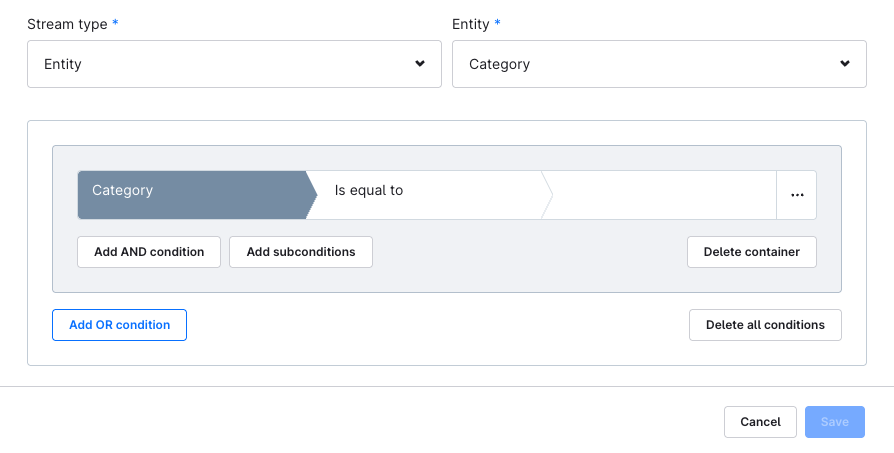
Manufacturer
Select Entity as the stream type and Manufacturer in the field that appears.
You will then be given the option to create rules that apply to manufacturers. This rule configuration is based on the Rule Builder. This allows you to create individual conditions for applying boosting.
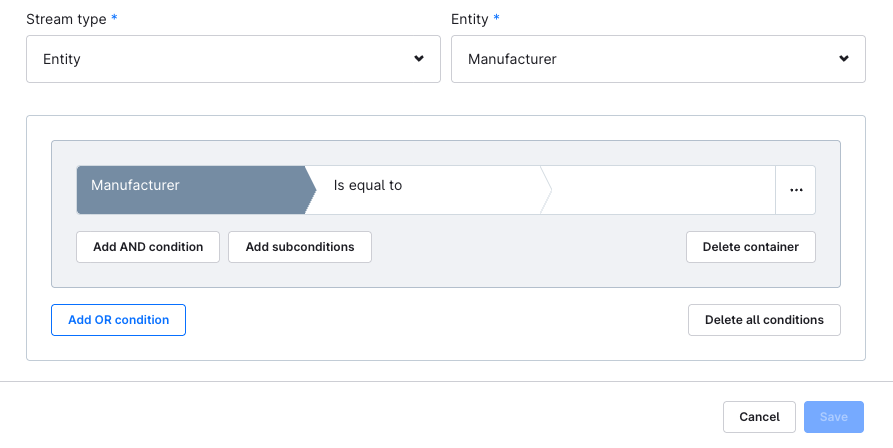
Actions
Using the actions (1), you can define redirects from customers to a product, category or URL. This is useful if you want to direct customers to a specific destination. For example, if you notice that customers often search for something specific, you could create a category with your own content and redirect them there.
You can create a new action using the Add Action button (2). Existing actions are displayed in the overview (3).
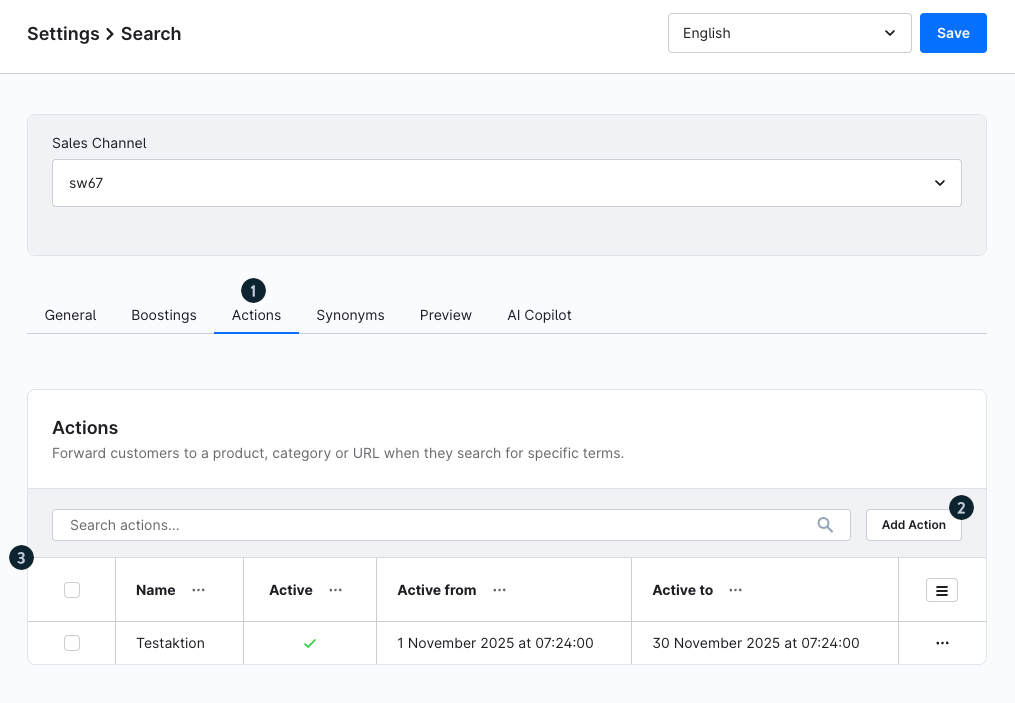
If you open the configuration via Add Action, you can make various settings here that will later ensure forwarding.

Name (1): Enter the name of your promotion here. The name will later be listed in the overview of different promotions.
- Active (2): Use this switch to activate or deactivate the promotion. Promotions are deactivated by default.
- Search terms (3): Enter one or more search terms here that should be redirected to your final destination.
- Active from / Active to (4): Define the desired time period for your action here.
- Forward to (5): Forward to a URL, category or directly to a product and then define the exact destination in the right-hand area (6).
With this example configuration, when the customer searches for the term ‘black weeks’, they are redirected directly to the Free time & electronics category, preventing the customer from seeing no results in this case.
Synonyms
In search, the use of the term "synonyms" usually refers to the function of search engines or search tools to display alternative terms or expressions that have a similar meaning to the search term entered. This feature helps users refine their search results by presenting them with similar terms or variations that may be relevant.
For example, if someone searches for "car", a search engine could potentially display synonyms such as "vehicle", "motor vehicle" or "passenger car" to provide the user with additional options. This makes it easier to find relevant information and expands the scope of search results.
When creating a new synonym, you have the option of using two different synonym rules. "Equivalence" or "Explicit mapping".
Equivalence

Terms such as "wifi, wlan, w-lan, wireless network" are completely equivalent. You can therefore select the synonym rule Equivalence for these and then enter these terms in the Search terms (1) field. The results for these search terms will then be included on the results page. Then optionally select a language (2) for which this rule should apply.
Explicit Mapping

Terms such as "iPhone, smartphone" are not completely equivalent. However, you may still want all smartphones to be found for the term iPhone. In this case, enter the term iPhone in the Search terms field (1). You can also add several terms here, such as Samsung or HTC.
Then enter the term smartphone in the Match to field (2). You can also enter several terms here, which will then be used as equivalents.
Finally, optionally select a language (3) for which this rule should apply.
Preview
In this area, you can preview search results based on a selected sales channel – without having to visit the storefront.
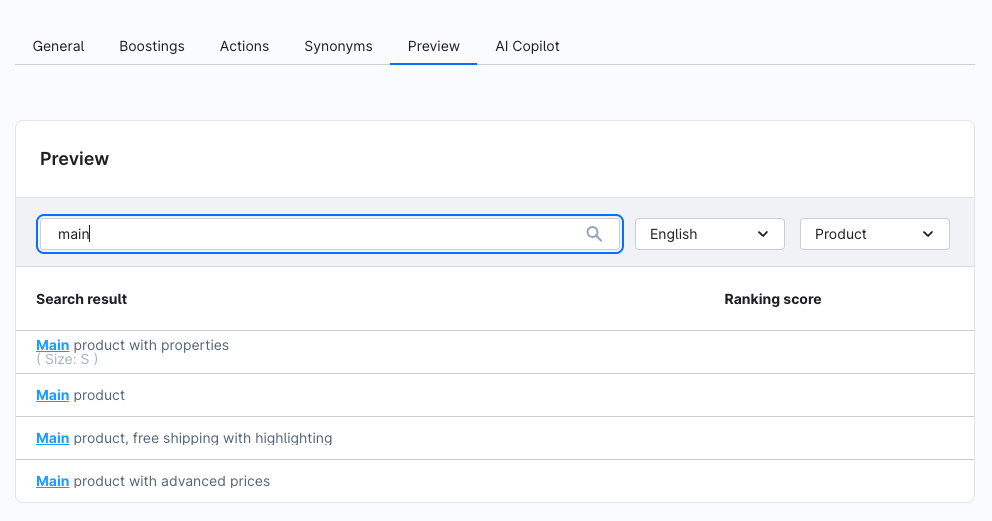
AI Copilot
AI Copilot offers a ‘magical’ search function in the storefront with context-based search. Buyers can use it to find products by describing their search intent in natural language. This feature is the first AI Copilot feature aimed directly at buyers.
The ‘AI Copilot’ tab will only be visible once the commercial extension is active and you have subscribed to at least the Shopware Rise plan.
Please note the selected language so that your changes are also visible in the corresponding sales channel with this language
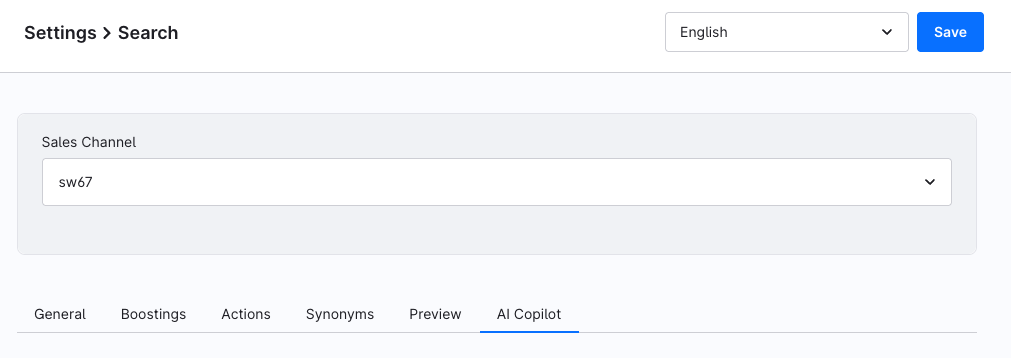
You can configure AI Copilot individually for each sales channel. To do this, select the desired sales channel from the drop-down menu.
To get the best search results, use the OR search and enable the option to search the description.
Sales channel context
Enter brief keywords here to describe the products or services offered in your shop. The algorithm uses this information to optimise the search results in your sales channel.
This field is mandatory – you cannot save your entries without filling it in.
If display errors occur, it helps to recompile the theme.

Search by context
Here you can activate and deactivate context-based search. This function is deactivated by default.
Please note that there is a limit to the number of keywords that can be entered in the context description search. The limit is 100 characters.

In fields Example 1 to Example 3, you can store examples that will be displayed to your customers as suggestions – for example, ‘I'm looking for a dress for a summer barbecue party’.
Search by image

Here you can enable or disable the ‘Search by images’ function. It is disabled by default.
Storefront view
Example with active Search by context
Here, we use an example to show you what the storefront would look like with active AI Copilot.
The AI Search symbol appears next to the search field of your store. If you click on the star symbol, you will be taken to the search wizard.

We have reached the search field and can now search for "vacation in Vietnam", for example. When we have finished our entry, we confirm this with the arrow to the right.

After a short time, the AI Search has found a suitable product in our shop on the subject of "vacation in Vietnam" and displays it in the storefront.
As the product descriptions and images for the products are missing in our example, the AI can only work with the existing product names and descriptions in this case, which makes the search less accurate. If you have stored all the information such as images, descriptions etc. for the products in your sales channel, the AI search can deliver correspondingly more accurate results.
Example of the search with images
Here we show you an example of what the storefront would look like with an active AI image search.
The AI Search icon with a camera appears next to your store's search field. If you click on the star symbol, you will be taken to the search wizard.

Next to the search field you will find a camera symbol.
View with a desktop PC/laptop:
If you click on the camera symbol, you will be taken to the upload area for the image. You can only upload an image in png or jpeg format using the ‘Select file’ button or drag & drop. The images will not be saved.

View with a mobile device (tablet/smartphone):
If you click on the camera icon, you can upload an already saved photo or take a new one.

After you have clicked on the Search button, you will find items in the store that are similar to the item in the picture. The output is limited to three search results, which display suitable products in a product slider. In our example, we uploaded a picture of make up and got the following search result:

